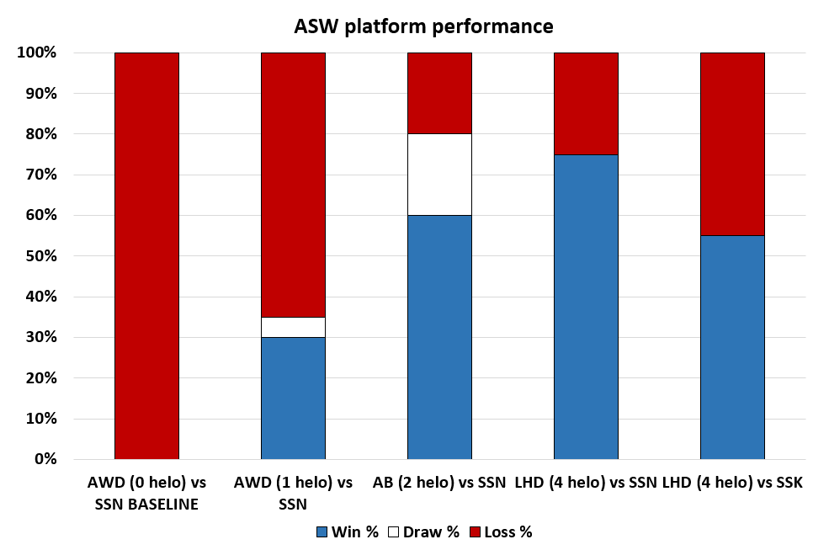Anti-submarine warfare (ASW) is an arcane science (and perhaps its practitioners prefer it that way), but it’s an incredibly important part of naval warfare. It’s also notoriously difficult—like trying to find the needle in a proverbial haystack—except that the needle might be trying to kill you. But as a rule of thumb, an effective ASW strategy uses assets to efficiently search the greatest volume of water possible in a given period of time.
Large surface combatants are slow at the best of times, and during ASW operations they move even slower to reduce noise. But the ship’s embarked ASW helicopters can move quickly, drop sonobuoys from the air, and deploy powerful dipping sonars. They can also carry torpedoes, disaggregating the entire kill chain from the warship.
It would be hard to overstate the value of aircraft to an ASW mission, but it can also be hard to demonstrate quantitatively. To that end, I conducted a series of simulated ASW scenarios using the program ‘Command: Modern Air/Naval Operations’, a spiritual successor to the classic (and realistic) Harpoon series of military-style simulators.
The test scenario isn’t meant to be ultra-realistic; it’s a 2,000nm2, deep-water arena, in which a submarine (red team) and a surface vessel (blue team) are hunting each other, with no time limit. The intent of the tests was to investigate the impact of having more helicopters on an ASW mission, rather than evaluating specific surface platforms. Don’t believe the numbers that come out—the scenario is artificial, and almost certainly skews the results in favour of the ASW side by boxing the submarine in—but you can believe the relativities.
The blue team embarks one or more MH-60R Seahawk ASW helicopters. The number of helicopters is dependent on the platform; one Seahawk on the Australian Hobart-class AWD, two Seahawks on the US Navy Arleigh Burke Flight IIA, and four Seahawks on the Australian Canberra-class LHD. All the platforms on each side patrol the mission area at random vectors until they detect an enemy and follow the kill chain through to conclusion.
A win for blue is defined as successfully defeating the enemy submarine while the surface ship remains intact. A draw is when both sides’ vessels are destroyed, usually because an already airborne helicopter drops a torpedo on a submarine after that submarine has destroyed the surface ship.
The baseline scenario tests an AWD with no helicopter onboard against a US Navy Virginia-class SSN. In that case the AWD loses every time. That’s not surprising; even when both vessels detect each other, the submarine’s Mk48 heavyweight torpedo has twice the range of the AWD’s MU90 lightweight torpedo, so the submarine can always pick the AWD off at a comfortable distance. (In fact, across all test scenarios, anti-submarine kills were always achieved by a helicopter-launched Mk54 torpedo.) ASW with no airborne sensors is a one-way mission for a surface combatant.

The AWD with a single Seahawk provides the bare minimum in airborne ASW capability, and wins outright 30% of the time and gets sunk 65% of the time. In comparison, an Arleigh Burke with two Seahawks, wins 60% of the time and gets sunk in 20% of trials.
The program models Seahawk sorties at a little under three hours duration, with a turnaround time of about four hours between sorties. That means the AWD has a Seahawk in the air just 40% of the time, while the Arleigh Burke has one in the air closer to 80% of the time. Even when the submarine manages to sneak a kill, there’s usually a Seahawk in the air that can use the surface ship’s final sensor data to even the score. (Some versions of the Arleigh Burke also include the ASROC rocket-launched torpedo, which results in more ‘draw’ scores, but in the interest of fair comparison to the AWD, I didn’t include ASROC).
The success rate increases again with the addition of more Seahawks, though not by much. The LHD scenario includes four Seahawks, three of which are on rotation so that one is in the air at all times, with the fourth flying when available. The results are all either win or loss, because the LHD has no sonar system that can see a torpedo coming. That means, unlike the AWD or Arleigh Burke, the airborne Seahawks can’t be cued by the LHD.
The final scenario tested whether a Collins-class SSK would fare any better than the Virginia SSN did against the LHD with four Seahawks. It turns out that the Collins was a little harder to detect than the Virginia, which is consistent with conventional wisdom that diesel-electric submarines tend to be quieter than their nuclear-powered counterparts.
The point of this simulation series wasn’t to attempt to recreate realistic operational scenarios, but to test the importance of ship-borne ASW helicopters to ASW. The conclusion is unequivocal (and not surprising): a surface vessel with two helicopters is going to be much better at ASW than a ship with only one. And the fact that an LHD, with no organic ASW sensors, but with four Seahawks performs even better than an Arleigh Burke with two tells you that ASW helicopters are probably the most valuable ASW capability you can put on a ship.

